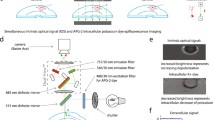Summary
Spreading Cortical Depression (SCD) is the hyper-excitation, followed by extreme suppression of spontaneous electrical activity in the cortex. This work models SCD propagation using current dipoles to represent excitable pyramidal cells. An area of cortex, either gyrus or sulcus, supporting SCD is represented by surface dipoles oriented perpendicular to the surface. Magnetic fields created by these individual surface dipoles are calculated using the Biot-Savart law. We have assumed a plane volume conductor to represent the sulcus to simplify the mathematical derivation. The sources included in cortical surface area of 10−4mm2 is represented by a signal dipole. The magnetic field arising from the entire excited area of the cortex is obtained by summing the fields due to these individual dipoles. The simulated waveforms suggest that the shapes, amplitudes, and durations of the SCD signals depend on the size of the active area of cortex involved in SCD, as well as the location and orientation of the detector. Using this dipole model, we are able to simulate the Large Amplitude Waves (LAWs) similar to those observed by Barkley et al. (1990) while measuring spontaneous activity from migraine headache patients using the assumption that these LAWs arise from propagation of SCD across a sulcus. The shape of the simulated LAW waveform is strongly influenced by the relationships between the detector location and orientation, the propagation direction of the SCD wave, and the orientation of the sulcus.
Similar content being viewed by others
References
Barkley, G.L., Tepley, N., Nagel-Leiby, S., Moran, J.E., Simkins, R.T., Welch, K.M.A. Magnetoencephalographic Studies of Migraine, Headache, 1990, 30: 428–434.
Barkley, G.L., Tepley, N., Moran, J.E., Welch, K.M.A. DC-MEG studies of migraine patients and controls. Proceeding of the 9th International Conference on Biomagnetism, Vienna, August 1993. In press.
Barkley, G.L., Tepley, N., Moran, J.E., Welch, K.M.A. Blinded analysis of MEG studies in migraine, New advances in headache research 3, F. Clifford Rose, ed. Smith-Gordon, 1994. PP 69–72.
Bures, J., Buresova, O., Krivanek, J.; The mechanism and applications of Leao's spreading depression of electroencephalographic activity, Academic Press, N.Y. 1974.
Cuffin, N.B., Cohen, D. Magnetic fields of a dipole in spherical volume conductor shapes. IEEE Trans. on Biomedical Eng. 1977, BME 24: 372–381.
Gardner-Medwin, A.R., Tepley, N., Barkley, G.L., Moran, J., Nagel-Leiby, S., Simkins, R.T., Welch, W.M.A. Magnetic fields associated with spreading depression in anaesthetized rabbits. Brain Research, 1991, 540: 153–158.
Grynszpan, F., Geselowitz, D.B. Model studies of the magnetocardiogram. Biophys. J., 1973, 13: 911–925.
Iramina, K., Ueno, K., Ueno, S. Influence of spreading neuronal electric sources on spatio temporal neuromagnetic fields, J. Appl. Physics, 1994 75: 7168–7170.
Jasper, H.H. Discussion in Jasper & Smirnov. The Moscow colloguia on electroencephalography of higher nervous activity. Electroencephy. Clin. Neurophysiol., 1960, Suppl 13, p 375.
Lashley, K. Patterns of cerebral integration indicated by the scotomas of migraine, Arch. Neurol. Psych., 1941, 46: 333–339.
Lauritzen, M.: Spreading Depression and Migraine, Path. Biol., 1992, 40: 332–337.
Leao, A.A.P., Morrison, R.S. Propagation of Spreading Depression. J. Neurophysiol., 1945, 8: 33–45.
Leao, A.A.P. Spreading depression of activity in the cerebral cortex. J. Neurophysiol., 1947, 7: 379–390.
Nunez, P.L. Localization of brain activity with Electroencephalography, in Advances in Neurology, vol 54 (Magnetoencephalography), S Sato ed, Raven Press, N. Y., 1990, pp 39–65.
Nunez, P.L. Locating Sources of the Brain's Electric and Magnetic Fields: Some Effects of Inhomogeneity and Multiple Sources, with Implications for the Future. HFOSL Technical Note 71-86-12, Human Factors and Organizational Systems Laboratory, Navy Personnel Research and Development Center, San Diego, CA, 1986.
Okada, Y., Lauritzen, M., Nicholson, C. Magnetic field associated with spreading cortical depression: a model for detection of migraine. Brain Research, 1988, 442: 185–190.
Sramka, M., Broack, G., Bures, J., Nadvornik, P. Functional ablation by spreading depression. Possible use in human stereotactic neurosurgery. Appl. Neurophysiol., 1977, 40: 48–61.
van Harreveld, A., Stamm, J.S. On the Conditions for Recording Leaos Spreading Depression. EEG Cln. Neurophysiol. 1951, 3: 323–328.
Wijesinghe, R.S., Tepley, N., Nunez, P.L. A Model for the Spreading Cortical Depression Waveforms in Migraine Patients. Proceedings NABMAG 2, 1994, Detroit, MI.
Wijesinghe, R.S. Comparison of electric and magnetic techniques for the determination of conduction velocity distributions of nerve bundles. Ph.D. Dissertation, Vanderbilt University, Nashville, TN, 1988.
Woods, R.P., Iacoboni, M., Mazziotta, J.C. Bilateral Spreading cerebral Hypoperfusion During Spontaneous Migraine Headache. N. Engl. J. Med, 1994, 331: 1689–1692.
Author information
Authors and Affiliations
Additional information
This research was supported by NIH/NINDS grant no. 1R01 NS30914. We gratefully acknowledge the cooperation of Dr. P.L. Nunez for his discussion and for providing the computer time for the simulations.
Rights and permissions
About this article
Cite this article
Tepley, N., Wijesinghe, R.S. A dipole model for Spreading Cortical Depression. Brain Topogr 8, 345–353 (1996). https://doi.org/10.1007/BF01186910
Accepted:
Issue Date:
DOI: https://doi.org/10.1007/BF01186910




